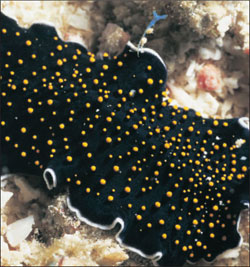Acoelomate Animals
For animals that spend their lives sitting and waiting, as do most members of the two radiate phyla we considered in the next section, radial symmetry is ideal. One side of the animal is just as important as any other for snaring prey coming from any direction. But if an animal is active in seeking food, shelter, home sites, and reproductive mates, it requires a different set of strategies and a new body organization. Active, directed movement requires an elongated body form with head (anterior) and tail (posterior) ends. In addition, one side of the body is kept up (dorsal) and the other side, specialized for locomotion, is kept down (ventral). What results is a bilaterally symmetrical animal in which the body can be divided along only one plane of symmetry to yield two halves that are mirror images of each other. Furthermore, since it is better to determine where one is going than where one has been, sense organs and centers for nervous control have come to be located on the head. This process is called cephalization. Thus cephalization and primary bilateral symmetry evolved together.The three acoelomate phyla considered in this section are not greatly more complex in organization than radiates except in symmetry. The evolutionary consequence of that development alone was enormous, however, for it is the type of symmetry assumed by all more complex animals.
The three phyla considered in this section have the simplest organization within the Bilateria, a grouping of phyla that includes all the rest of the animal kingdom. These three are Platyhelminthes (Gr. platys, flat, + belmins, worm), or flatworms; Nemertea (Gr. Nemertes, one of the nereids, unerring one), or ribbon worms; and Gnathostomulida (Gr. gnathos, jaw, + stoma, mouth, + L. ulus, dim.), or jaw worms. They have only one internal space, the digestive cavity, with the region between the ectoderm and endoderm filled with mesoderm in the form of muscle fibers and mesenchyme (parenchyma). Since they lack a coelom or a pseudocoel, they are termed acoelomate bilateral animals (Figure 14-1), and because they have three well-defined germ layers, they are triploblastic. Acoelomate bilateria show more specialization and division of labor among their organs than do radiate animals because the mesoderm makes more elaborate organs possible; thus, acoelomate bilateria are said to have reached the organ-system level of organization.
These phyla belong to the protostome division of the Bilateria and typically have spiral cleavage. They have some centralization of the nervous system, with a concentration of nerves anteriorly and a ladder-type arrangement of trunks and connectives down the body. They have an excretory (or osmoregulatory) system, and the nemerteans also have a circulatory system. They also have a one-way digestive system, with an anus as well as a mouth.
Position in Animal Kingdom
- Platyhelminthes, or flatworms, Nemertea, or ribbon worms, and Gnathostomulida, or jaw worms, are the simplest animals to have primary bilateral symmetry.
- These phyla have only one internal space, a digestive cavity, with the region between the ectoderm and endoderm filled with mesoderm in the form of muscle fibers and mesenchyme (parenchyma). Since they lack a coelom or a pseudocoelom, they are termed acoelomate Bilateria, and because they have three well-defined germ layers, they are termed triploblastic.
- Acoelomate bilateral animals show more specialization and division of labor among their organs than do radiate animals because the mesoderm makes more elaborate organs possible. Thus the acoelomates are said to have reached the organsystem level of organization.
- They belong to the protostome division of the Bilateria and have spiral cleavage, and at least platyhelminths and nemerteans have determinate (mosaic) cleavage.
Biological Contributions
- Acoelomate Bilateria developed the basic bilateral plan of organization that has been widely exploited in the animal kingdom.
- Mesoderm developed into a welldefined embryonic germ layer (triploblastic), making available a great source of tissues, organs, and systems.
- Along with bilateral symmetry, cephalization was established. Some centralization of the nervous system evident in theladder type of systemfound in flatworms.
- Along with the subepidermal musculature, there is also a mesenchymal system of muscle fibers.
- They are the simplest animals with an excretory system.
- Nemerteans are the simplest animals to have a circulatory system with blood and a one-way alimentary canal. Although not stressed by zoologists, the rhynchocoel cavity in ribbon worms is technically a true coelom, but because it is merely a part of the proboscis mechanism, it is probably not homologous to the coelom of eucoelomate animals.
- Unique and specialized structures occur in all three phyla. The parasitic habit of many flatworms has led to many specialized adaptations, such as organs of adhesion.






